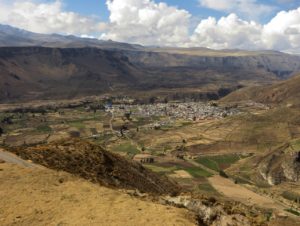
Alumnae expand applied ecology to Latin America – NEW AGU session
Two NREL alumnae, Dr. Nell Campell and Dr. Erika Foster aim to encourage collaboration across critical zone sites in Latin America. They encourage biogeochemists to submit to the following session for the American Geophysical Union Dec 9-13, 2019 in San Francisco, CA (SUMIT TODAY JULY 31):
B045 – Expanding the Critical Zone concept to examine biogeochemistry in Latin America and beyond
Read more of Erika’s story below:
“Hurdling down the twisting road in Peru, our bus turns a final corner, bringing into view the tiny pueblo of Chivay nestled in between foothills in the Andes.

Today our team of Purdue faculty, postdocs and undergraduates meet with a small organic farmer cooperative associated with the nonprofit DESCOSUR (Centro de Estudios y Promoción del Desarrollo del Sur). We reach the two quinoa plots early in the morning, and greet the president of the organization along with several small holder farmers. Two teams each take a soil auger to sample in small sections down until the first rock layer. Students, farmers and researchers help to lay the soil layers carefully onto a tarp so we can observe the soil profiles. Here we compare soils from two farms, one highly managed by the community and a second slightly-neglected privately owned farm. We slowly describe each layer in Spanish to the farmers, which then is translated into Quechua, and we can all clearly observe differences in soil color and the large amount of rock fragments in the private plot.
From basic observations we discuss the work of the farmers to maintain weed-free plots and common cultivation techniques. As the Purdue researchers share information about the physical, biological, and chemical properties that form healthy soil and both men and women Andean producers share generations of intimate knowledge of the landscape, specific cultivars, and soil quality. The lively knowledge exchange allows the farmers and researchers from two hemispheres to find common ground.” -Dr. Erika Foster, NREL Alumna 2018
This field demonstration day exemplifies one of many critical science communication components within a newly formed partnership between Purdue and the Universidad Nacional de San Agustin (UNSA): the Arequipa Nexus Institute. The main objective of the Nexus is to promote sustainable development with the southern Arequipa region in Peru. This region contains a unique number of ecosystem types, as precipitation ranges from <10 mm to >700 mm annually, and elevation sweeps from 0 to 5800m. Along these gradients, the Purdue-UNSA research team delves into many fascinating basic science questions within the critical zone. Research with the critical zone is interdisciplinary and examines biogeochemical processes of the Earth’s surface, spanning the lower atmosphere, vegetation canopies, soils, groundwater, and bedrock. For example, one small project examines the accumulation, stability and quality of carbon within an agricultural chronosequence in the desert, along with how heavy metal contamination correlates to organic matter accumulation. The team will share these results, as well as studies of heavy metal contamination, and maps of land use change in the region over the last several decades at this year’s American Geophysical Union Conference (Dec 9-13, 2019). The Nexus team, and researchers from Brazil and Mexico will convene a session to build a network for critical zone research within Latin America (B045).
Again, today, July 31 is the final day for submission of abstracts, so please consider submission of research biogeochemistry within the critical zone in Latin America or other international field sites and attending this session in December.
B045 – Expanding the Critical Zone concept to examine biogeochemistry in Latin America and beyond
Research with the Critical Zone (CZ) is interdisciplinary and examines biogeochemical processes of the Earth’s surface, spanning the lower atmosphere, vegetation canopies, soils, groundwater, and bedrock. The CZ network includes sites in North America and Europe, but also extends to South America, Africa, Asia, and Oceania. This session aims to showcase international and interdisciplinary biogeochemical CZ research with abstracts that: 1) quantify how changes in land use/cover alter CZ biogeochemistry; 2) examine the ramifications of disturbance on the CZ, including human activities and natural disasters; 3) highlight interactions between CZ biogeochemistry and science-based management like the food-water-energy nexus and soil health; and 4) demonstrate the importance of scaling and modeling within the CZ to inform management. This session provides a platform for interdisciplinary collaboration and idea generation within the CZ community for future international studies to enhance our understanding of the structure and functioning of the human-natural world.